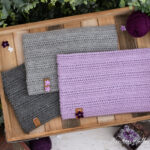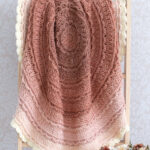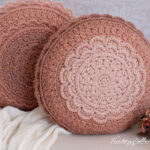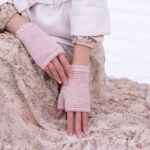Layers of beautiful texture make up this free crochet baby blanket pattern! It’s full of clusters, post stitches, delicate lines of “polka-dots”, and all topped off by a pretty, scalloped edge. Crochet this easy blanket for your daughter, granddaughter, niece, or even yourself! Find the free crochet pattern instructions below, or purchase a print-optimized, ad-free PDF by clicking here.
Usually I stick to single colors when playing with texture but this blanket is a bit different. I’ve used soft “baby” hues combined with the various stitches to create something as tender and delicate as your little bundle of joy. It’s an heirloom quality blanket that will fit into most any nursery setting.
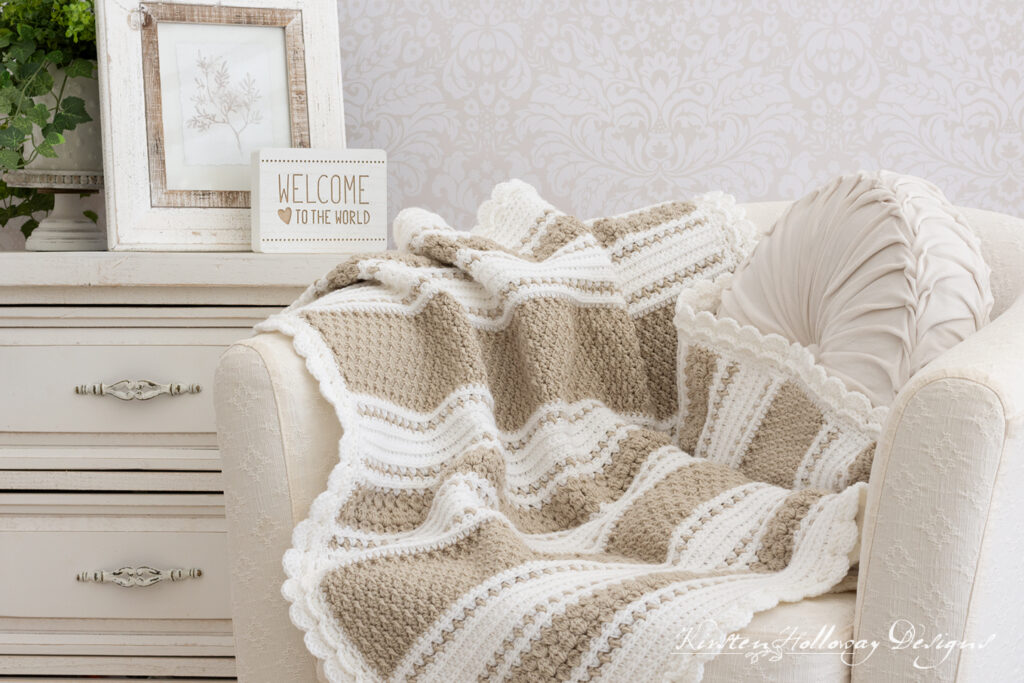
For this blanket I used Bernat Baby Sport because it’s a no-fuss acrylic yarn that should handle multiple washings well. I also love that it comes in several neutral colors and not only pastel pink/green/yellow/blue, so you can customize this to fit many nursery color schemes.
Let’s talk stitches for a minute. As with most of my patterns I like to use crochet stitches that most of you will know, but use them in ways that look unique. You will need to know cluster stitches, post stitches, shells, and the “Elizabeth” stitch, which is a lot like the bead stitch. I use a variation of the Alpine stitch which is popular right now so if you have crocheted something with that stitch in the past you should be able to recognize it fairly easily in this design. If you’re not sure what these stitches are, don’t worry–I’ve written the instructions out in the notes, or you’ll find them in the crochet pattern itself.

Wrap her up in it for church, or a take it on a trip with her to the park, or when visiting relatives. I know you will find so many uses for this sweet little blanket!

Disclaimer: This post contains affiliate links. When you purchase something using these links a small percentage of the sales price goes to me. However, you do not pay any extra for the item you purchase.
Difficulty:
Easy/Intermediate
Techniques used: working in the 3rd loop of a half-double crochet, Cluster stitches, Elizabeth stitch, Shell stitch, post stitches.
Materials Needed:
4.5mm hook, or hook needed to obtain gauge
1560 (2170, 2410, 4000, 5620, 6630, 8840, 13750) yards #3 Bernat Baby Sport in “White”, and “Baby Taupe“, or 2-3 colors of your choice
Yarn needle
Scissors
Stitch markers
Stitches Used:
ch = chain
sl st = slip stitch
sc = single crochet
hdc = half double crochet
dc = double crochet
FPdc = front post double crochet
Additional Terms:
Working in the 3rd loop of hdc: Look at the top of the stitch, and locate the sideways “V”, bend the stitch to look at the back, and you should see another “V”. You’ll be working into the back loop of that “V”, this is called the 3rd loop.
2dc cluster: YO, insert hook into stitch, pull up a loop, YO, draw through 2 loops (1st stitch of cluster made), YO, insert hook into same st, pull up a loop, YO draw through 2 loops (2nd st of cluster made), YO, draw through all loops on hook.
4dc cluster: YO, insert hook into stitch, pull up a loop, YO, draw through 2 loops (1st stitch of cluster made), YO, insert hook into same st, pull up a loop, YO draw through 2 loops (2nd st of cluster made), YO, insert hook into same st, pull up a loop, YO, draw through 2 loops (3rd st of cluster made), YO, insert hook into same st, pull up a loop, YO, draw through 2 loops (4th st of cluster made), YO, draw through all loops on hook.
Elizabeth Stitch: insert hook into st, yo, draw up a loop, yo, insert hook into same st, draw up a loop, yo pull through all 4 loops on hook. These stitches should be as tall as a sc stitch.
RS = right side
WS = wrong side
sk = skip
st/sts = stitch/stitches
sp/sps = space/spaces
prev = previous
Gauge:
Approximately 13 hdc sts in 4”
Measurements:
(These are approximate dimensions)
Baby Blanket: 36″ x 36″ – ch 114
Crib Blanket: 36″ x 50″ – ch 114
Toddler Blanket: 40″ x 50″ – ch 130
Small Throw: 52″ x 64″ – ch 178
Large Throw: 60″ x 78″ – ch 194
Twin, Queen, and King sizes are included in the print-optimized, ad-free PDF
Additional Notes:
–This pattern contains a lot of notes to hopefully make it easier to understand. Please read through them carefully before you begin.
-ch-1 or ch-2 at beginning of row does not count as a stitch.
-ch-3 or ch-4 at beginning of row does count as a stitch/stitch + ch.
-Color changes at the beginning of a new row can be done with a chainless starting method.
-In order to keep the textured ridges created when working the hdc in the 3rd loop on the “right” side of the blanket you will periodically be asked to to cut your yarn and attach to the opposite end with the “right side” facing. See notes in pattern
-If you are crocheting this blanket in 1 solid color, as opposed to the 2 or 3 I recommend, you will not have quite as many ends to weave in, but you will still be cutting and reattaching your yarn periodically to keep the texture on the “right side” of the blanket. Purchase yarn for a 2-color blanket in approximately a 2:1 ratio.
-Want to figure out yardage for a 3-color blanket instead? The 2:1 ratio is still where you will, want to start. Using the total yardage for the blanket you want to make (listed in the Materials Needed section), divide the total into 3rds. Your main color will be 2/3 of the yarn, and your color B and C will be the remaining 1/3. Divide that number in half and that will be what you need for colors B and C. For example, if you were wanting to make a receiving blanket you would need 1560 yards total. 1560/3 = 520. 520+520 = 1040, which will be your color A. Now divide the remaining 520 in half and you get 260. You will need approximately 260 yards for color B, and 260 yards for color C.
-The scalloped blanket edging is worked in multiples of 4 + 3, and does not match perfectly with the horizontal row number counts (which are worked in multiples of 16 +1, +1). You will need to do a little “eyeballing” and a tiny amount of math (if you know what even and odd numbers are you’ll be fine) which I explain before the blanket edging. If you want a plain blanket edging (no math required) I have included notes for that too.
Parfait Vintage-Style Baby Blanket Crochet Pattern (US Terms):
Click here to purchase an ad-free, print-optimized PDF of this pattern on LoveCrafts
OR
Pick up the printable version of this pattern on Etsy instead
This blanket consists of a variety of horizontal textured “stripes”. A complete set of “stripes” measures about 13″-14″ tall depending on how tall you make your stitches. This stripe pattern sequence will change slightly based on the height (or length) of the blanket. The stripe pattern is essentially several rows of stitches worked into the 3rd loop of a hdc stitch, a section of the Elizabeth Stitch, a section of cluster stitches, followed by another section of the Elizabeth stitch, several more rows of working into the 3rd loop, another section of the Elizabeth stitch, and finishes up with the modified Alpine stitch and another section of the Elizabeth stitch, before starting over from the beginning. I have written 3 colors into this pattern, but you are welcome to use only 2 colors. In that case you would switch back to color B where it says to use color C.
To complete the design with the same stitch pattern on both ends of the blanket requires about 5″ of extra height, so if you want to make a custom length (longer or shorter) you will want to factor that in. See my notes further down on the Large Throw. Keep in mind that the border adds an additional 3″ of width/height, but I have included that in my measurement calculations. The numbers in brackets and parentheses are your over-all stitch counts for the row based on the size you wish to crochet.
With color A (Baby Grey, or White),
Ch 114, [114, 130, 178, 194])
Row 1 (RS): hdc in 2nd ch from hook, hdc in each remaining chain, ch 1, turn. (113, [113, 129, 177, 193])
Row 2 (WS): working in 3rd loop of hdc, sc in each st across, ch 1, turn. (113, [113, 129, 177, 193])
Row 3 (RS): hdc in each st across, ch 1, turn. (113, [113, 129, 177, 193])
Row 4 (WS): working in 3rd loop of hdc, sc in each st across, ch 1, turn. (113, [113, 129, 177, 193])
Row 5 (RS): hdc in each st across, ch 1, turn. (113, [113, 129, 177, 193])
Row 6 (WS): working in 3rd loop of hdc, sc in each st across, ch 1, turn. (113, [113, 129, 177, 193])
Drop color A and fasten off.
Join color B (Baby Pink, or Taupe),
Row 7 (RS): sc in first st, Elizabeth stitch in next st, *ch 1, sk st, Elizabeth stitch in next st; repeat from * across, sc in final st of row. (56, [56, 64, 88, 96] Elizabeth sts, 55, [55, 63, 87, 95] ch-1 sps, 2 sc)
Drop color B and fasten off.
In this next row your stitch count will come up one less than it has been. We will add that stitch back in the following row.
With RS facing, join color A to opposite end of row,
Row 8 (RS): hdc in first st, sk st, *2 hdc in ch-1 sp, sk st; repeat from * across, hdc in final st of row, ch 1, turn. (112, [112, 128, 176,192])
This is the row we will be adding an extra stitch to in the very middle of the row to bring our counts back in line with what they had been earlier. You may fold your blanket in half and mark the center fold as the place to work your increase or you can use the numbers listed in the pattern. Either way the row count should increase by 1. You’ll see this same idea repeat in rows 14, 17, 24, 46
Row 9 (WS): working in 3rd loop of hdc, sc in next 56, [56, 64, 88, 96] sts, 2 sc in next st, sc in next 55, [55, 63, 87, 95] sts. (113, [113, 129, 177, 193])
Drop color A, and fasten off.
With color C (White),
Row 10 (RS): dc in first st, ch 1, *sk st, 4dc cluster in next st, ch 1; repeat from * across, dc in final st of row, ch 3 (counts as first dc of next row) turn. (55, [55, 63, 87, 95] 4-dc clusters, 2 dc, 56, [56, 64, 88, 96] ch-1 sps)
Row 11 (WS): 2dc cluster in first ch-1 sp, ch 1, sk st, *4dc cluster in next ch-1 sp, ch 1, sk st; repeat from * across, in final ch-sp work 2dc cluster, dc in final st of row, ch 4 (counts as first dc + ch-1 of next row), turn. (54, [54, 62, 86, 94] 4dc clusters, 2 2dc clusters, 55, [55, 63, 87, 95] ch-1 sps, 2 dc)
Row 12 (RS): sk st, *4dc cluster in next st, ch 1 sk st; repeat from * across, dc in final st of row (this is the top of 3rd ch). (55, [55, 63, 87, 95] 4-dc clusters, 2 dc, 56, [56, 64, 88, 96,] ch-1 sps)
Drop color C and fasten off.
With RS facing, attach color A yarn to opposite end of row,
Row 13: (RS) hdc in first st (3rd ch), hdc in ch-1 sp, sk st, *2 hdc in next ch-1 sp, sk st; repeat from * across, when you arrive at end of row work 1 hdc, in final ch-1 sp, hdc in final st of row, ch 1, turn. (112, [112, 128, 176, 192])
Row 14 (WS): working in 3rd loop of hdc, sc in next 56, [56, 64, 88, 96] sts, 2 sc in next st, sc in next 55, [55, 63, 87, 95] sts. (113, [113, 129, 177, 193])
Drop color A, and fasten off.
Join color B,
Row 15 (RS): sc in first st, Elizabeth stitch in next st, *ch 1, sk st, Elizabeth stitch in next st; repeat from * across, sc in final st of row. (56, [56, 64, 88, 96] Elizabeth sts, 55, [55, 63, 87, 95] ch-1 sps, 2 sc)
Drop color B and fasten off.
With RS facing, attach color A yarn to opposite end of row,
Row 16 (RS): hdc in first st, sk st, *2 hdc in ch-1 sp, sk st; repeat from * across, hdc in final st of row. (112, [112, 128, 176, 192])
Row 17 (WS): working in 3rd loop of hdc, sc in next 56, [56, 64, 88, 96] sts, 2 sc in next st, sc in next 55, [55, 63, 87, 95] sts, ch 1, turn. (113, [113, 129, 177, 193])
Row 18 (RS): hdc in each st across, ch 1, turn. (113, [113, 129, 177, 193])
Row 19 (WS): working in 3rd loop of hdc, sc in each st across, ch 1, turn. (113, [113, 129, 177, 193])
Row 20 (RS): hdc in each st across, ch 1, turn. (113, [113, 129, 177, 193])
Row 21 (WS): working in 3rd loop of hdc, sc in each st across. (113, [113, 129, 177, 193])
Drop color A, and fasten off.
Join color C,
Row 22 (RS): sc in first st, Elizabeth stitch in next st, *ch 1, sk st, Elizabeth stitch in next st; repeat from * across, sc in final st of row. (56, [56, 64, 88, 96] Elizabeth sts, 55, [55, 63, 87, 95] ch-1 sps, 2 sc)
Drop color C, and fasten off.
With RS facing, attach color A yarn to opposite end of row,
Row 23 (RS): hdc in first st, sk st, *2 hdc in ch-1 sp, sk st; repeat from * across, hdc in final st of row, ch 1, turn. (112, [128, 176, 192])
Row 24 (WS): working in 3rd loop of hdc, sc in next 56 [56, 64, 88, 96] sts, 2 sc in next st, sc in next 55, [55, 63, 87, 95, 119, 159, 175] sts, ch 1, turn. (113, [113, 129, 177, 193])
Drop color A, and fasten off.
This next section is a modified version of the Alpine Stitch. You’ll notice that it’s basically the same idea, but instead of using dc stitches it uses hdc between each FPdc stitch and is slightly flatter in texture. You may use dc instead though if you prefer.
Join color B,
Row 25 (RS): hdc in each st across, ch 1, turn. (113, [113, 129, 177, 193])
Row 26 (WS): sc in each st across, ch 1, turn. (113, [113, 129, 177, 193])
You will be working across 2 rows in this next row: the current row, and the row 2 rows below. Be sure to leave the stitch behind the FPdc unworked otherwise you will end up increasing which is not what we want in this section. When you are repeating rows 27-30 and you see references to row 25 and 27, know that in the repeats you will be working the FPdc stitches around the stitch that is 2 rows below your current row. For example, when you do row 31 you’ll work around row 29, and when you work row 33 you’ll work around row 31, etc. One quick and easy way to make sure you’ve completed this section the way I did is to make sure you have 8 rows of FPdc going at a diagonal across that part.
Row 27 (RS): hdc in first st of current row, FPdc around 2nd hdc st from row 25 , *hdc in next st in current row, sk st in row 25, FPdc around next hdc; repeat from * across, hdc in final st of row, ch 1, turn. (113, [113, 129, 177, 193])
Row 28 (WS): sc in each hdc and in each FPdc st across, ch 1, turn. (113, [113, 129, 177, 193])
Row 29 (RS): FPdc around first hdc from row 27, *hdc in next st of current row, sk st in row 27, FPdc around next hdc; repeat from * across, hdc in final st, ch 1, turn. (113, [113, 129, 177, 193])
Row 30 (WS): sc in each hdc and in each FPdc st across, ch 1, turn. (113, [113, 129, 177, 193])
Repeat rows 27-30 2 times, then repeat rows 27-29 once.
Drop color B, and fasten off.
With RS facing, attach color A yarn to opposite end of row,
Row 42 (RS): hdc in each st across, ch 1, turn. (113, [113, 129, 177, 193])
Row 43 (WS): working in 3rd loop of hdc, sc in each st across. (113, [113, 129, 177, 193])
Drop color A and fasten off.
Join color C,
Row 44 (RS): sc in first st, Elizabeth stitch in next st, *ch 1, sk st, Elizabeth st in next st; repeat from * across, sc in final st of row. (56, [56, 64, 88, 96] Elizabeth sts, 55, [55, 63, 87, 95] ch-1 sps, 2 sc)
Drop color C and fasten off.
With RS facing, attach color A yarn to opposite end of row,
Row 45 (RS): hdc in first st, sk st, *2 hdc in ch-1 sp, sk st; repeat from * across, hdc in final st of row, ch 1, turn. (112, [128, 176, 192])
Row 46 (WS): working in 3rd loop of hdc, sc in next 56, [56, 64, 88, 96] sts, 2 sc in next st, sc in next 55, [55, 63, 87, 95] sts, ch 1, turn. (113, [113, 129, 177, 193])
Row 47 (RS): hdc in each st across, ch 1, turn. (113, [113, 129, 177, 193])
Row 48 (WS): working in 3rd loop of hdc, sc in each st across, ch 1, turn. (113, [113, 129, 177, 193])
Row 49 (RS): hdc in each st across, ch 1, turn. (113, [113, 129, 177, 193])
Row 50 (WS): working in 3rd loop of hdc, sc in each st across. (113, [113, 129, 177, 193])
Drop color A and fasten off.

Repeat rows 7-50:
1 time for 36″ x 36″ Baby Blanket,
2 times for 36″ x 50″ Crib blanket, or 40″ x 50″ Toddler Blanket,
3 times for 52″ x 64″ Small Throw,
4 times for 60″ x 78″ Large throw*,
Then repeat rows 7-20 once. This will add a cluster stripe that is the same style as what you started the blanket pattern with.
*Note: This makes the Large Throw a little longer than average (which is 72″), but you can omit most of this last part on that size if you wish to keep it shorter, Just repeat rows 7 and 8 only before moving to the edging.
You will now move to the scalloped edging.
Scalloped Edging:
This edging is worked on the RS of your blanket, in multiples of 4 + 3. This is different than what the blanket is worked in so you will need to make some small adjustments to your stitch counts in round 2 so that the rest of the edging goes on smoothly. I’ve explained things in the following notes so please read them carefully. If you really get stuck I’ve put together a picture tutorial for the edging over here at the bottom of the post. It also includes a cute little mug rug (coaster) pattern. Use your main color (A) for the trim section.

**This following row (row 1) will be worked around 3 edges (side, top, and other side) of your blanket.**
The round after this (round 2) will begin across the bottom edge of the blanket, just after you finish the 3rd edge. If you want a plain edging just follow the instructions in row 1, then for round 2 work rsc (crab stitch) around the entire blanket to give it a nice edge. Go down a hook size or two for that round so the edge doesn’t pucker. Just remember, if you decide to do this plain edging your blanket will be a couple inches smaller than the measurements given in the notes at the beginning of the pattern. You will also want to block it since the cluster stripes are a little bit wider than the other parts of the blanket (the scalloped edging hides a lot of this).
Row 1 (RS): attach working yarn to bottom right corner, working along raw edge toward top of blanket, evenly space sc in multiples of 4 + 3, ch 1, now working along the top edge of the blanket in 3rd loop of hdc, hdc in each st across, ch 1, working along second side of the blanket, evenly space sc in multiples of 4 + 3 along raw edge (your counts for both sides need to be the same), ch 1, join with sl st to first hdc of bottom edge. Do not turn. (Stitch counts will vary based on length of blanket)
Notes for rounds 2 and 3: Each shell from round 3 will take up 2 ch-1 sps to make. So, you need to have spaces worked in a multiple of 2 + 1 (ie. an odd number) along all 4 edges in Round 2. If you worked your side edge counts in multiples of 4 + 3 those edges should match up just fine and it will only be the top and bottom edges that you’ll need to keep an eye on. *Do not include the ch-1 sp in your corners as part of that ch-1 sp count for each side*.
In my sample blanket I needed to add an extra ch-1 sp on the top and bottom edges so that I would end up with an odd number of ch-sps. To add my extra ch-sp I actually had to modify my edge in 2 places. The modification is simply making an increase which looks like this: sc in next st, ch 1, sc in next st. Notice how you don’t skip any sts between the ch-1 and the next sc? Easy-peasy. After you have completed the increase go back to working the row as you normally would. I divvied up my blanket into 3rds and worked that increase in both marked places, like so (stitch markers are circled):

The ch-1 sps in each corner should be bordered by 2 sc sts on each side of the space. This is why you have to work an increase on top and bottom edges in 2 spots.
For the white and taupe sample blanket (smallest size) I had 57 ch-1 sps along top and bottom, and 59 ch-1 sps along both side edges at the end of the following round.
Round 2: sc in next st, *ch 1, sk st, sc in next st* repeat from * to * across bottom of blanket, sc in final st of row, ch 1, continue working along side edge, sc in next 2 sts, **ch 1, sk st, sc in next st** repeat from ** to **, sc in final st of row, ch 1, continue working along top edge, and down the other edge repeating the round from the very beginning, sc in final st of row, ch 1, sc in ch-sp at beginning of round, join with sl st to first sc. (Stitch counts will vary)
Round 3: sk st, sl st into ch-1 sp, sk st, *5 dc in next ch-1 sp, sk st, sl st in next ch-1 sp, sk st* repeat from * to * across, at end of row sk 2 sts, 8 dc in ch-1 sp at corner, sk 2 sts, sl st in next ch-1 sp, sk st, **5dc in next ch-1 sp, sk st, sl st in next ch-1 sp, sk st; repeat from ** to ** across, at end of row sk 2 sts, 8 dc in ch-1 sp at corner, sk 2 sts, sl st in next ch-1 sp, sk st; repeat from * to end of row, final sl st counts as join. (Shell counts will vary)
In the following round all sl sts will be skipped.
Round 4: ch 2, *working across shell: BPhdc around first st, BPsc around next 3 sts, BPhdc around last st of shell*, repeat from * to *, when you arrive at end of row work this sequence across the shell in the corner: BPhdc around next 2 sts, BPsc around next 2 sts, ch 1, BPsc around next 2 sts, BPhdc around next 2 sts; repeat from * around, join with sl st to first BPhdc. (Stitch counts will vary)
Round 5: *sk 2 sts, 6 dc in next st, sk 2 sts, sl st between the 1st and 2nd BPhdc in a row from prev round; repeat from * to end of row, sk 4 sts, in ch-1 sp at corner work 11 dc, sk 4 sts, repeat entire round from *, final sl st counts as join. (Shell counts will vary)
Fasten off, and weave in ends.
Block if desired.
.sdg.
Want more gorgeous crochet patterns, and a little encouragement for your day? Sign up for my newsletter here! That way you’ll never miss out on special events, or freebies I’m offering.
JOIN ME ON SOCIAL MEDIA
I would love to see a picture when you’re done, so please feel free to come by my Facebook group and show off your finished project! Be sure to tag @kirstenhollowaydesigns when you share pictures of your project on Instagram!
You can also follow me on Facebook, Pinterest, Instagram, and Ravelry for more beautiful crochet patterns.
PATTERN TERMS AND CONDITIONS:
You are welcome to share the link to this pattern, using one image of your choice, on your site, but please do not share the written patterns themselves, this includes my Ravelry downloads or translations of these patterns, or use additional images. You do not have permission to use my images by themselves to create pinnable graphics for Pinterest, however they may be included in a roundup pin if there are 4 or more other patterns. If you sell finished items online, please do not use my pictures for your listings. I’m positive that your work is of high enough quality for you to sell the finished piece. Have confidence in your abilities! <3 Thank you!
This pattern was made to be used by individuals and small business crocheters alike. Selling your finished pieces in boutiques, at farmer’s markets, craft shows, and other local events is encouraged! Please credit/link Kirsten Holloway Designs when selling finished products online. The only thing I require is that this pattern not be used commercially to produce hundreds of thousands of copies. If you enjoyed this pattern or found it useful, why not share a link to this post with your friends?


